San Giorgio, is the Italian form of Saint George. When used as the name of a person it is frequently contracted to Sangiorgio.

The Scuola Grande di San Marco is a building in Venice, Italy, designed by the well-known Venetian architects Pietro Lombardo, Mauro Codussi, and Bartolomeo Bon. It was originally the home to one of the Scuole Grandi of Venice, or six major confraternities, but is now the city's hospital. It faces the Campo Santi Giovanni e Paolo, one of the largest squares in the city.

Castello is the largest of the six sestieri of Venice, Italy.
The Scuole Grandi were confraternity or sodality institutions in Venice, Italy. They were founded as early as the 13th century as charitable and religious organizations for the laity. These institutions had a key role in the history and development of music. The first groups of bowed instrument players named Violoni were born there in the early 16th century.
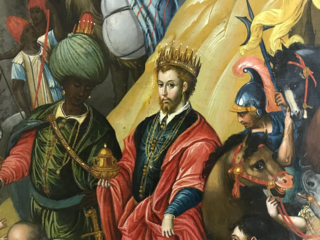
Michael Damaskenos or Michail Damaskenos was a leading post-Byzantine Cretan painter. He is a major representative of the Cretan School of painting that flourished in the 16th and 17th centuries. Painters Georgios Klontzas and Damaskenos were major contributors to the Cretan School during the same period. Damaskinos traveled all over the Venetian Empire painting. He remained loyal to his Greek roots stylistically but incorporated some Italian elements in his work. He was strongly influenced by the Venetian school. He painted parts of the Cathedral of San Giorgio dei Greci. Damaskenos has 100 known works. He influenced the works of Theodore Poulakis.

San Giorgio dei Greci is a church in the sestiere (neighborhood) of Castello, Venice, northern Italy. It was the center of the Scuola dei Greci, the Confraternity of the Greeks in Venice. Around this period there was a similar church in Naples called Santi Pietro e Paolo dei Greci. There was also a Greek Brotherhood of Naples.

Emmanuel Tzanes, also known as BounialisEmmanuel Tzane-Bounialis, Emmanuel Zane, and Emmanuel Tzane, was a Greek Renaissance iconographer, author, clergyman, and educator. He spent the latter half of his life in Venice, where he was parish priest of the church of San Giorgio dei Greci and a member of the Flanginian School run by the city's Greek Confraternity. Tzanes wrote icons in the style of the Cretan School, influenced by contemporary trends in Venetian painting. His known extant works, over 130 in number, can be found in public foundations, private collections, churches and monasteries in Greece. The most popular of these is The Holy Towel, finished in 1659. Tzanes was a collaborator with Philotheos Skoufos, and brothers with the painter Konstantinos Tzanes and the poet Marinos Tzanes.
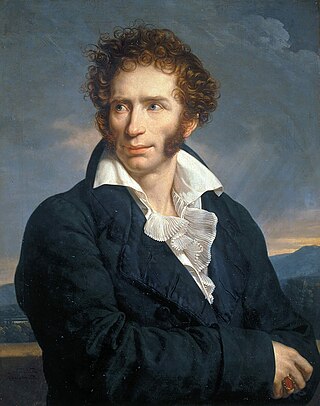
Greeks in Italy have been present since the migrations of traders and colonial foundations in the 8th century BC, continuing down to the present time. Nowadays, there is an ethnic minority known as the Griko people, who live in the Southern Italian regions of Calabria and Apulia, especially the peninsula of Salento, within the ancient Magna Graecia region, who speak a distinctive dialect of Greek called Griko. They are believed to be remnants of the ancient and medieval Greek communities, who have lived in the south of Italy for centuries. A Greek community has long existed in Venice as well, the current centre of the Greek Orthodox Archdiocese of Italy and Malta, which in addition was a Byzantine province until the 10th century and held territory in Morea and Crete until the 17th century. Alongside this group, a smaller number of more recent migrants from Greece lives in Italy, forming an expatriate community in the country. Today many Greeks in Southern Italy follow Italian customs and culture, experiencing assimilation.

The Scuola Grande di San Giovanni Evangelista is a confraternity building located in the San Polo sestiere of the Italian city of Venice. Founded in the 13th century by a group of flagellants it was later to become one of the five Scuole Grandi of Venice. These organisations provided a variety of charitable functions in the city as well as becoming patrons of the arts. The Scuola Grande di San Giovanni Evangelista is notable for housing a relic of the true cross and for the series of paintings it commissioned from a number of famous Venetian artists depicting Miracles of the Holy Cross. No longer in the school, these came into public ownership during the Napoleonic era and are now housed in the Gallerie dell'Accademia. The scuola is open to visitors on a limited number of days, detailed on the official website.
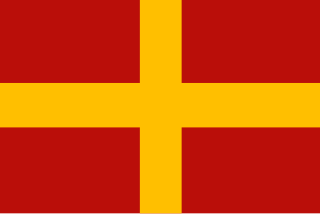
The Republic of Ancona was a medieval commune and maritime republic on the Adriatic coast of modern-day Italy, notable for its economic development and maritime trade, particularly with the Byzantine Empire and Eastern Mediterranean, although somewhat confined by Venetian supremacy on the sea. It enjoyed excellent relations with the Kingdom of Hungary, was an ally of the Republic of Ragusa, and maintained good relations with the Ottoman Empire. All these relationships enabled it to serve as central Italy's gateway to the Orient.

The Greek community in Venice dates back to the Middle Ages, when the Republic of Venice was still formally part of the Byzantine Empire. Settled mostly in the sestiere of Castello, it reached its height in the centuries after the Fall of Constantinople, when many Greeks, including merchants, soldiers, and scholars, fled the Ottoman conquest. Tied to the Greek world through its extensive overseas possessions, the city became a major center for Greek education and the Modern Greek Enlightenment, but declined after the Fall of the Venetian Republic and the establishment of the modern Greek state. The community's property is now largely owned and managed by the Hellenic Institute of Byzantine and Post-Byzantine Studies in Venice.
This is an alphabetical index of people, places, things, and concepts related to or originating from the Republic of Venice. Feel free to add more, and create missing pages.
The Scuole Piccole of Venice are confraternities in the Republic of Venice. Unlike the more famous Scuole Grandi, membership in them was not restricted to citizens and indeed some of them were formed specifically for foreigners. Most Scuole, the scolae communes, were devoted to a particular saint or devotional cult, but some, the scuole delle arti, were associated with specific crafts or trade guild, and often obligatory for the members of that trade.

Philotheos Skoufos was a Greek painter, educator and clergyman during the 17th century. He collaborated with Emmanuel Tzanes on several pieces while he was in Corfu. Philotheos was a member of the Cretan School and Heptanese School. His work was influenced by the Venetian school. He was briefly affiliated with the famous Greek church in Venice San Giorgio dei Greci. Emmanuel Tzanes and Konstantinos Tzanes were also in Venice around the same period and affiliated with San Giorgio dei Greci. He was the priest who presided over famous painter Ioannis Moskos's wedding. Philotheos was active on the Ionian Island while Theodore Poulakis and Elias Moskos also had active workshops. Skoufos most popular works were the Stoning of St Stephen and the Virgin in the Temple.
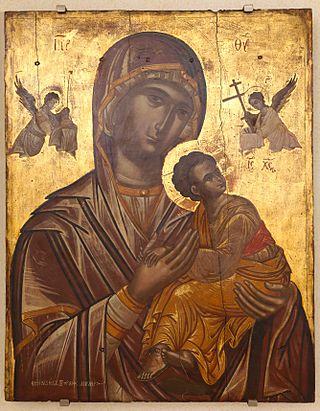
Emmanuel Tzanfournaris, also known as Emmanouil Manos was a Greek painter. He was a painter in Corfu and Venice. He was taught by famous painter Thomas Bathas. Emmanuel's father Georgios was also a famous painter. Emmanuel was active within the Greek Community of Venice until 1625. Some of his paintings are in the church of San Giorgio dei Greci. He was influenced by Michael Damaskinos and other Venetian painters. Tzanfournaris adopted the Venetian school but also stayed loyal to the maniera greca. He influenced the works of countless painters namely Emmanuel Tzanes, Franghias Kavertzas, Philotheos Skoufos and his son Theofilakto Tzanfournaris. Tzanfournaris artwork can be found all over the world. Sixteen of his paintings have survived.

Konstantinos Tzanes was a Greek Renaissance painter. He was a painter in Crete and Venice. His brother Emmanuel Tzanes was the parish priest of the church of San Giorgio dei Greci. Emmanuel Tzanes was also a famous painter and author. Konstantinos followed the Venetian style and in some instances completely broke from the maniera greca. His other brother Marinos Tzanes was a famous poet. Konstantinos's work influenced both Greek and Italian Painters. His most popular work is the painting by Mary Magdalene which is at the Greek Institute in Venice.
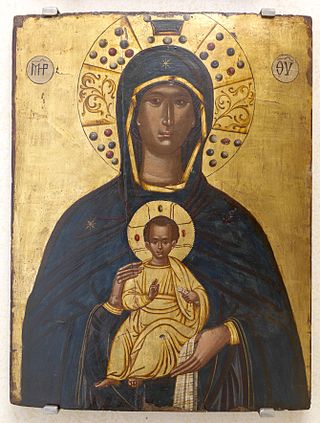
Thomas Bathas was a Greek painter, educator, and Vikar. He employed the maniera greca in some of his work but he also broke from tradition by employing the Venetian style. He traveled around the Venetian Empire going from Heraklion to Corfu and Venice. He was a prominent member of the Greek Confraternity in Venice. He was friends with Gabriel Severus, Metropolitan of Philadelphia. He was very popular among both Greek and Italian patrons. He influenced the works of countless artists both Italian and Greek. Some of his works are in San Giorgio dei Greci and the Hellenic Institute of Venice. Emmanuel Tzanes, Konstantinos Tzanes, Ioannis Moskos, and Philotheos Skoufos were some Greek artists influenced by his work. One of his students was the famous painter Emmanuel Tzanfournaris. He left him a fortune in his will. His most famous works include: Portrait of Gabriel Severus and Virgin and Child Enthroned. Twenty of his paintings have survived.
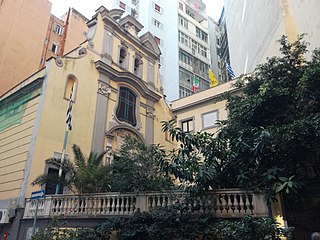
Santi Pietro e Paolo dei Greci is a church at the Campania, the historic center of Naples, in Via San Tommaso d'Aquino 51. It was the center of the Scuola dei Greci in Naples and the Confraternity of the Greeks in Naples. Around this period there was a similar church in Venice called San Giorgio dei Greci. There was also a Greek Brotherhood of Venice. A prominent member of the Greek Brotherhood was famous painter Belisario Corenzio. The church was initially dedicated to the Twelve Apostles. They began building the church at the request of one of the descendants of the Byzantine Empire Thomas Asen Palaiologos. The church currently belongs to the Greek State.

Giovanni Kyprios, also known as Zuane Ciprioto and Ioannis Kyprios. He was a Greek painter from Cyprus living in Venice. Other Greek painters living in Venice around the same period were Thomas Bathas and Emmanuel Tzanfournaris. Kyprios was active during the second part of the 16th century. He was associated with famous painter Tintoretto. Kyprios painted in the traditional Byzantine style. He mixed the traditional Byzantine style with Venetian painting. His work was also influenced by the Cretan artists namely Michael Damaskinos. According to the Institute of Neohellenic Research, eight paintings are attributed to Kyprios. His most notable work is the Dome at San Giorgio dei Greci.















